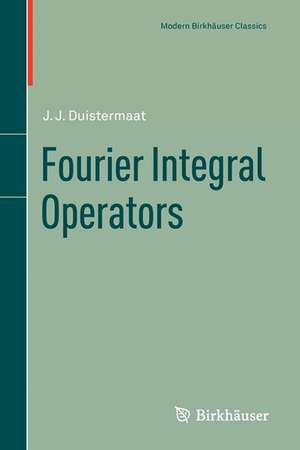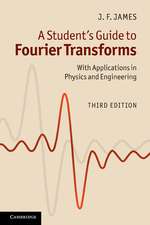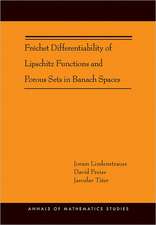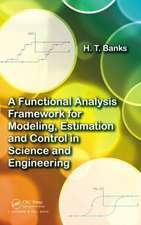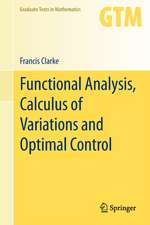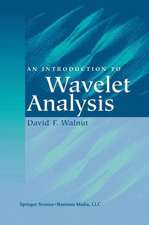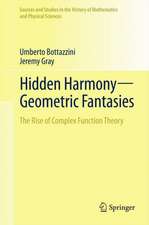Fourier Integral Operators: Modern Birkhäuser Classics
Autor J.J. Duistermaaten Limba Engleză Paperback – 11 noi 2010
Din seria Modern Birkhäuser Classics
- 8%
 Preț: 401.45 lei
Preț: 401.45 lei - 15%
 Preț: 468.12 lei
Preț: 468.12 lei -
 Preț: 477.65 lei
Preț: 477.65 lei - 15%
 Preț: 579.52 lei
Preț: 579.52 lei -
 Preț: 394.87 lei
Preț: 394.87 lei - 15%
 Preț: 469.09 lei
Preț: 469.09 lei - 20%
 Preț: 298.64 lei
Preț: 298.64 lei - 18%
 Preț: 747.20 lei
Preț: 747.20 lei - 15%
 Preț: 691.59 lei
Preț: 691.59 lei -
 Preț: 489.87 lei
Preț: 489.87 lei - 18%
 Preț: 785.11 lei
Preț: 785.11 lei -
 Preț: 390.08 lei
Preț: 390.08 lei - 15%
 Preț: 471.53 lei
Preț: 471.53 lei - 15%
 Preț: 534.17 lei
Preț: 534.17 lei - 15%
 Preț: 701.72 lei
Preț: 701.72 lei - 18%
 Preț: 792.34 lei
Preț: 792.34 lei - 15%
 Preț: 581.98 lei
Preț: 581.98 lei - 15%
 Preț: 639.41 lei
Preț: 639.41 lei - 15%
 Preț: 468.90 lei
Preț: 468.90 lei -
 Preț: 385.08 lei
Preț: 385.08 lei - 15%
 Preț: 540.89 lei
Preț: 540.89 lei - 18%
 Preț: 796.13 lei
Preț: 796.13 lei - 18%
 Preț: 904.60 lei
Preț: 904.60 lei - 15%
 Preț: 536.63 lei
Preț: 536.63 lei -
 Preț: 383.33 lei
Preț: 383.33 lei -
 Preț: 384.31 lei
Preț: 384.31 lei - 15%
 Preț: 689.28 lei
Preț: 689.28 lei - 15%
 Preț: 499.43 lei
Preț: 499.43 lei -
 Preț: 419.21 lei
Preț: 419.21 lei -
 Preț: 399.29 lei
Preț: 399.29 lei - 15%
 Preț: 578.01 lei
Preț: 578.01 lei - 15%
 Preț: 643.34 lei
Preț: 643.34 lei - 18%
 Preț: 732.70 lei
Preț: 732.70 lei -
 Preț: 508.54 lei
Preț: 508.54 lei -
 Preț: 394.51 lei
Preț: 394.51 lei -
 Preț: 458.19 lei
Preț: 458.19 lei -
 Preț: 386.39 lei
Preț: 386.39 lei - 15%
 Preț: 588.69 lei
Preț: 588.69 lei -
 Preț: 391.61 lei
Preț: 391.61 lei - 15%
 Preț: 578.24 lei
Preț: 578.24 lei - 15%
 Preț: 583.45 lei
Preț: 583.45 lei - 15%
 Preț: 501.06 lei
Preț: 501.06 lei - 20%
 Preț: 384.03 lei
Preț: 384.03 lei - 15%
 Preț: 594.89 lei
Preț: 594.89 lei -
 Preț: 453.60 lei
Preț: 453.60 lei - 18%
 Preț: 796.45 lei
Preț: 796.45 lei - 15%
 Preț: 694.55 lei
Preț: 694.55 lei - 15%
 Preț: 523.22 lei
Preț: 523.22 lei
Preț: 479.67 lei
Nou
Puncte Express: 720
Preț estimativ în valută:
91.78€ • 96.09$ • 75.95£
91.78€ • 96.09$ • 75.95£
Carte tipărită la comandă
Livrare economică 05-19 aprilie
Preluare comenzi: 021 569.72.76
Specificații
ISBN-13: 9780817681074
ISBN-10: 0817681078
Pagini: 142
Ilustrații: IX, 142 p.
Dimensiuni: 155 x 235 x 8 mm
Greutate: 0.23 kg
Ediția:2011
Editura: Birkhäuser Boston
Colecția Birkhäuser
Seria Modern Birkhäuser Classics
Locul publicării:Boston, MA, United States
ISBN-10: 0817681078
Pagini: 142
Ilustrații: IX, 142 p.
Dimensiuni: 155 x 235 x 8 mm
Greutate: 0.23 kg
Ediția:2011
Editura: Birkhäuser Boston
Colecția Birkhäuser
Seria Modern Birkhäuser Classics
Locul publicării:Boston, MA, United States
Public țintă
GraduateCuprins
Preface.- 0. Introduction.- 1. Preliminaries.- 1.1 Distribution densities on manifolds.- 1.2 The method of stationary phase.- 1.3 The wave front set of a distribution.- 2. Local Theory of Fourier Integrals.- 2.1 Symbols.- 2.2 Distributions defined by oscillatory integrals.- 2.3 Oscillatory integrals with nondegenerate phase functions.- 2.4 Fourier integral operators (local theory).- 2.5 Pseudodifferential operators in Rn.- 3. Symplectic Differential Geometry.- 3.1 Vector fields.- 3.2 Differential forms.- 3.3 The canonical 1- and 2-form T* (X).- 3.4 Symplectic vector spaces.- 3.5 Symplectic differential geometry.- 3.6 Lagrangian manifolds.- 3.7 Conic Lagrangian manifolds.- 3.8 Classical mechanics and variational calculus.- 4. Global Theory of Fourier Integral Operators.- 4.1 Invariant definition of the principal symbol.- 4.2 Global theory of Fourier integral operators.- 4.3 Products with vanishing principal symbol.- 4.4 L2-continuity.- 5. Applications.- 5.1 The Cauchy problem for strictly hyperbolic differential operators with C-infinity coefficients.- 5.2 Oscillatory asymptotic solutions. Caustics.- References.
Recenzii
From the reviews:
This book remains a superb introduction to the theory of Fourier integral operators. While there are further advances discussed in other sources, this book can still be recommended as perhaps the very best place to start in the study of this subject.
—SIAM Review
This book is still interesting, giving a quick and elegant introduction to the field, more adapted to nonspecialists.
—Zentralblatt MATH
The book is completed with applications to the Cauchy problem for strictly hyperbolic equations and caustics in oscillatory integrals. The reader should have some background knowledge in analysis (distributions and Fourier transformations) and differential geometry.
—Acta Sci. Math.
“Duistermaat’s Fourier Integral Operators had its genesis in a course the author taught at Nijmegen in 1970. … For the properly prepared and properly disposed mathematical audience Fourier Integral Operators is a must. … it is a very important book on a subject that is both deep and broad.” (Michael Berg, The Mathematical Association of America, May, 2011)
This book remains a superb introduction to the theory of Fourier integral operators. While there are further advances discussed in other sources, this book can still be recommended as perhaps the very best place to start in the study of this subject.
—SIAM Review
This book is still interesting, giving a quick and elegant introduction to the field, more adapted to nonspecialists.
—Zentralblatt MATH
The book is completed with applications to the Cauchy problem for strictly hyperbolic equations and caustics in oscillatory integrals. The reader should have some background knowledge in analysis (distributions and Fourier transformations) and differential geometry.
—Acta Sci. Math.
“Duistermaat’s Fourier Integral Operators had its genesis in a course the author taught at Nijmegen in 1970. … For the properly prepared and properly disposed mathematical audience Fourier Integral Operators is a must. … it is a very important book on a subject that is both deep and broad.” (Michael Berg, The Mathematical Association of America, May, 2011)
Notă biografică
Hans Duistermaat was a geometric analyst, who unexpectedly passed away in March 2010. His research encompassed many different areas in mathematics: ordinary differential equations, classical mechanics, discrete integrable systems, Fourier integral operators and their application to partial differential equations and spectral problems, singularities of mappings, harmonic analysis on semisimple Lie groups, symplectic differential geometry, and algebraic geometry. He was co-author of eleven books.
Duistermaat was affiliated to the Mathematical Institute of Utrecht University since 1974 as a Professor of Pure and Applied Mathematics. During the last five years he was honored with a special professorship at Utrecht University endowed by the Royal Netherlands Academy of Arts and Sciences. He was also a member of the Academy since 1982. He had 23 PhD students.
Duistermaat was affiliated to the Mathematical Institute of Utrecht University since 1974 as a Professor of Pure and Applied Mathematics. During the last five years he was honored with a special professorship at Utrecht University endowed by the Royal Netherlands Academy of Arts and Sciences. He was also a member of the Academy since 1982. He had 23 PhD students.
Textul de pe ultima copertă
This volume is a useful introduction to the subject of Fourier integral operators and is based on the author's classic set of notes. Covering a range of topics from Hörmander’s exposition of the theory, Duistermaat approaches the subject from symplectic geometry and includes applications to hyperbolic equations (= equations of wave type) and oscillatory asymptotic solutions which may have caustics.
This text is suitable for mathematicians and (theoretical) physicists with an interest in (linear) partial differential equations, especially in wave propagation, resp. WKB-methods. Familiarity with analysis (distributions and Fourier transformation) and differential geometry is useful. Additionally, this book is designed for a one-semester introductory course on Fourier integral operators aimed at a broad audience.
This book remains a superb introduction to the theory of Fourier integral operators. While there are further advances discussed in other sources, this book can still be recommended as perhaps the very best place to start in the study of this subject.
—SIAM Review
This book is still interesting, giving a quick and elegant introduction to the field, more adapted to nonspecialists.
—Zentralblatt MATH
The book is completed with applications to the Cauchy problem for strictly hyperbolic equations and caustics in oscillatory integrals. The reader should have some background knowledge in analysis (distributions and Fourier transformations) and differential geometry.
—Acta Sci. Math.
This text is suitable for mathematicians and (theoretical) physicists with an interest in (linear) partial differential equations, especially in wave propagation, resp. WKB-methods. Familiarity with analysis (distributions and Fourier transformation) and differential geometry is useful. Additionally, this book is designed for a one-semester introductory course on Fourier integral operators aimed at a broad audience.
This book remains a superb introduction to the theory of Fourier integral operators. While there are further advances discussed in other sources, this book can still be recommended as perhaps the very best place to start in the study of this subject.
—SIAM Review
This book is still interesting, giving a quick and elegant introduction to the field, more adapted to nonspecialists.
—Zentralblatt MATH
The book is completed with applications to the Cauchy problem for strictly hyperbolic equations and caustics in oscillatory integrals. The reader should have some background knowledge in analysis (distributions and Fourier transformations) and differential geometry.
—Acta Sci. Math.
Caracteristici
Based on author’s original lecture notes Covers a broad range of topics Useful for both practitioners and students Applications put theory in context Includes supplementary material: sn.pub/extras
